
The hilt (rarely called a haft or shaft) is the handle of a knife, dagger, sword, or bayonet, consisting of a guard, grip, and pommel. The guard may contain a crossguard or quillons. A tassel or sword knot may be attached to the guard or pommel.

The hilt (rarely called a haft or shaft) is the handle of a knife, dagger, sword, or bayonet, consisting of a guard, grip, and pommel. The guard may contain a crossguard or quillons. A tassel or sword knot may be attached to the guard or pommel.

The pommel (Anglo-Norman pomel "little apple" [1] ) is an enlarged fitting at the top of the handle. They were originally developed to prevent the sword from slipping from the hand. From around the 11th century in Europe they became heavy enough to be a counterweight to the blade. [2] This gave the sword a point of balance not too far from the hilt allowing a more fluid fighting style. Depending on sword design and swordsmanship style, the pommel may also be used to strike the opponent (e.g., using the Mordhau technique).
Pommels have appeared in a wide variety of shapes, including oblate spheroids, crescents, disks, wheels, and animal or bird heads. They are often engraved or inlayed with various designs and occasionally gilt and mounted with jewels. Ewart Oakeshott introduced a system of classification of medieval pommel forms in his The Sword in the Age of Chivalry (1964) to stand alongside his blade typology. [3] Oakeshott pommel types are enumerated with capital letters A–Z, with subtypes indicated by numerals.

The grip is the handle of the sword. It is usually made of wood or metal and often covered with shagreen (untanned tough leather or shark skin). Shark skin proved to be the most durable in temperate climates but deteriorates in hot climates. Consequently, rubber became popular in the latter half of the 19th century. Many sword types alternatively opt for ray skin, referred to in katana construction as same. Whatever material covers the grip, it is usually both glued on and wrapped with wire in a helix.
The guard is just above the grip. It is a common misconception that the cross-guard protects the wielder's entire hand from the opposing sword; only with the abandonment of the shield and then the armoured gauntlet did a full hand guard become necessary. The crossguard still protected the user from a blade that was deliberately slid down the length of the blade to cut off or injure the hand.
Early swords do not have true guards but simply a form of stop to prevent the hand slipping up the blade when thrusting as they were invariably used in conjunction with a shield.
From the 11th century, European sword guards took the form of a straight crossbar (later called "quillon") perpendicular to the blade.
Beginning in the 16th century in Europe, guards became more and more elaborate, with additional loops and curved bars or branches to protect the hand. A single curved piece alongside the fingers (roughly parallel with the handle/blade and perpendicular to any crossguards) was referred to as a knuckle-bow. [4]
Ultimately, the bars could be supplemented or replaced with metal plates that could be ornamentally pierced. The term "basket hilt" eventually came into vogue to describe such designs, and there are a variety of basket-hilted swords.
Simultaneously, emphasis upon the thrust attack with rapiers and smallswords revealed a vulnerability to thrusting. By the 17th century, guards were developed that incorporated a solid shield that surrounded the blade out to a diameter of up to two inches or more. Older forms of this guard retained the quillons or a single quillon, but later forms eliminated the quillons, altogether being referred to as a cup-hilt. This latter form is the basis of the guards of modern foils and épées.
The ricasso is a blunt section of blade just below the guard. On developed hilts it is protected by an extension of the guard. [5] On two-handed swords, the ricasso provided a third hand position, permitting the user's hands to be further apart for better leverage.


The sword knot or sword strap, sometimes called a tassel, is a lanyard—usually of leather but sometimes of woven gold or silver bullion, or more often metallic lace—looped around the hand to prevent the sword being lost if it is dropped. Although they have a practical function, sword knots often had a decorative design. For example, the British Army generally adopted a white leather strap with a large acorn knot made out of gold wire for infantry officers at the end of the 19th century. Such acorn forms of tassels were called 'boxed', which was the way of securing the fringe of the tassel along its bottom line such that the strands could not separate and become entangled or lost. Many sword knots were also made of silk with a fine, ornamental alloy gold or silver metal wire woven into it in a specified pattern.
The art and history of tassels are known by its French name, passementerie, or Posamenten as it was called in German. The military output of the artisans called passementiers (ornamental braid, lace, cord, or trimmings makers) is evident in catalogs of various military uniform and regalia makers of centuries past. The broader art form of passementerie, with its divisions of Decor, Clergy and Nobility, Upholstery, Coaches and Livery, and Military, is covered in a few books on that subject, none of which are in English.
Indian swords had the tassel attached through an eyelet at the end of the pommel.
Chinese swords, both jian and dao , often have lanyards or tassels attached. As with Western sword knots, these serve both decorative and practical functions, and the manipulation of the tassel is a part of some jian performances.
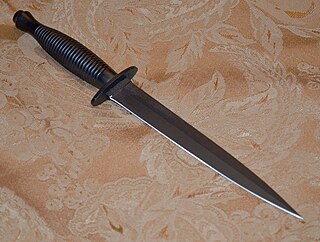
A dagger is a fighting knife with a very sharp point and usually one or two sharp edges, typically designed or capable of being used as a cutting or thrusting weapon. Daggers have been used throughout human history for close combat confrontations, and many cultures have used adorned daggers in ritual and ceremonial contexts. The distinctive shape and historic usage of the dagger have made it iconic and symbolic. A dagger in the modern sense is a weapon designed for close-proximity combat or self-defense; due to its use in historic weapon assemblages, it has associations with assassination and murders. Double-edged knives, however, play different sorts of roles in different social contexts.
A sword is an edged, bladed weapon intended for manual cutting or thrusting. Its blade, longer than a knife or dagger, is attached to a hilt and can be straight or curved. A thrusting sword tends to have a straighter blade with a pointed tip. A slashing sword is more likely to be curved and to have a sharpened cutting edge on one or both sides of the blade. Many swords are designed for both thrusting and slashing. The precise definition of a sword varies by historical epoch and geographic region.

A longsword is a type of European sword characterized as having a cruciform hilt with a grip for primarily two-handed use, a straight double-edged blade of around 80 to 110 cm, and weighing approximately 2 to 3 kg.

The jian is a double-edged straight sword used during the last 2,500 years in China. The first Chinese sources that mention the jian date to the 7th century BCE, during the Spring and Autumn period; one of the earliest specimens being the Sword of Goujian. Historical one-handed versions have blades varying from 45 to 80 centimeters in length. The weight of an average sword of 70-centimetre (28-inch) blade-length would be in a range of approximately 700 to 900 grams. There are also larger two-handed versions used for training by many styles of Chinese martial arts.

Dao are single-edged Chinese swords, primarily used for slashing and chopping. They can be straight or curved. The most common form is also known as the Chinese sabre, although those with wider blades are sometimes referred to as Chinese broadswords. In China, the dao is considered one of the four traditional weapons, along with the gun, qiang (spear), and the jian, called in this group "The General of Weapons".

The small sword or smallsword is a light one-handed sword designed for thrusting which evolved out of the longer and heavier rapier of the late Renaissance. The height of the small sword's popularity was during the 18th century, when any civilian or soldier with pretensions to gentlemanly status would have worn a small sword daily.
The French estoc is a type of sword, also called a tuck in English, in use from the 14th to the 17th century. It is characterized by a cruciform hilt with a grip for two-handed use and a straight, edgeless, but sharply pointed blade around 36 to 52 in in length. It is noted for its ability to pierce mail armor.

The kampilan is a type of single-edged sword, traditionally used by various ethnic groups in the Philippine archipelago. It has a distinct profile, with the tapered blade being much broader and thinner at the point than at its base, sometimes with a protruding spikelet along the flat side of the tip. The design of the pommel varies between ethnic groups, but it usually depicts either a buaya (crocodile), a bakunawa, a kalaw (hornbill), or a kakatua (cockatoo)..

A kilij is a type of one-handed, single-edged and curved scimitar used by the Seljuk Empire, Timurid Empire, Mamluk Empire, Ottoman Empire, and other Turkic khanates of Eurasian steppes and Turkestan. These blades developed from earlier Turko-Mongol sabers that were in use in lands controlled or influenced by the Turkic peoples.

The talwar, also spelled talwaar and tulwar, is a type of curved sword or sabre from the Indian subcontinent.
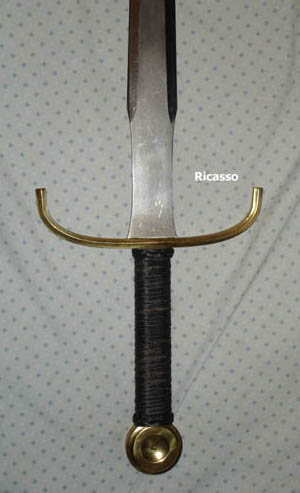
A ricasso is an unsharpened length of blade just above the guard or handle on a knife, dagger, sword, or bayonet. Blades designed this way appear at many periods in history in many parts of the world and date back to at least the Bronze Age — essentially, as long as humans have shaped cutting tools from metals.

The Oakeshott typology is a way to define and catalogue the medieval sword based on physical form. It categorises the swords of the European Middle Ages into 13 main types, labelled X through XXII. The historian and illustrator Ewart Oakeshott introduced it in his 1960 treatise The Archaeology of Weapons: Arms and Armour from Prehistory to the Age of Chivalry.

The shashka or shasqua is a kind of North Caucasian sabre; a single-edged, single-handed, and guardless backsword. The comparatively subtle curve of a shashka blade puts the weapon midway between a typically curved sabre and a straight sword, effective for both cutting and thrusting.
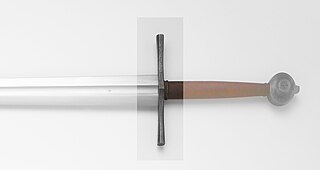
A sword's crossguard or cross-guard is a bar between the blade and hilt, essentially perpendicular to them, intended to protect the wielder's hand and fingers from opponents' weapons as well as from one's own blade. Each of the individual bars on either side is known as a quillon or quillion.
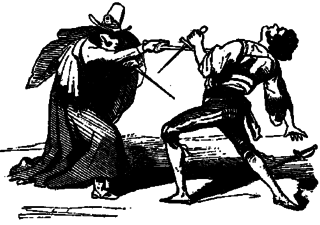
The parrying dagger is a category of small handheld weapons from the European late Middle Ages and early Renaissance. These weapons were used as off-hand weapons in conjunction with a single-handed sword such as a rapier. As the name implies they were designed to parry, or defend, more effectively than a simple dagger form, typically incorporating a wider guard, and often some other defensive features to better protect the hand as well. They may also be used for attack if an opportunity arises. The general category includes two more specific types, the swordbreaker and trident dagger.
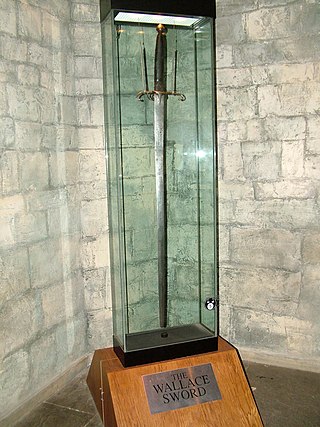
The Wallace Sword is an antique two-handed sword purported to have belonged to William Wallace (1270–1305), a Scottish knight who led a resistance to the English occupation of Scotland during the First War of Scottish Independence. It is said to have been used by William Wallace at the Battle of Stirling Bridge in 1297 and the Battle of Falkirk (1298).

A claymore is either the Scottish variant of the late medieval two-handed sword or the Scottish variant of the basket-hilted sword. The former is characterised as having a cross hilt of forward-sloping quillons with quatrefoil terminations and was in use from the 15th to 17th centuries.
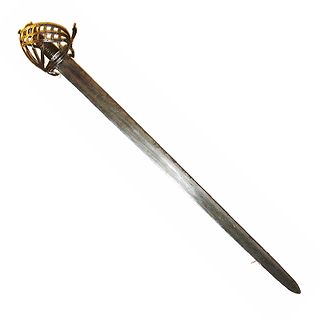
The basket-hilted sword is a sword type of the early modern era characterised by a basket-shaped guard that protects the hand. The basket hilt is a development of the quillons added to swords' crossguards since the Late Middle Ages. In modern times, this variety of sword is also sometimes referred to as the broadsword.
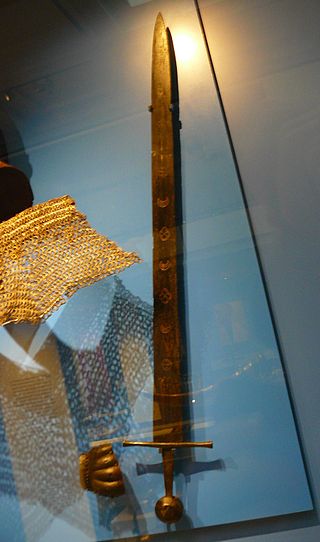
In the European High Middle Ages, the typical sword was a straight, double-edged weapon with a single-handed, cruciform hilt and a blade length of about 70 to 80 centimetres. This type is frequently depicted in period artwork, and numerous examples have been preserved archaeologically.

Ratings of the Royal Navy have used cutlasses, short, wide bladed swords, since the early 18th century. These were originally of non-uniform design but the 1804 Pattern, the first Navy-issue standard cutlass, was introduced at the start of the 19th century. This was a bluntish weapon that was perhaps intended for cutting away canvas and ropes rather than as a thrusting combat weapon. The 1845 Pattern cutlass introduced a bowl-style hand guard which provided greater protection, with a longer and more curved blade. Its sharper point made it more useful for thrusting attacks, which were now emphasised in the drill manual. The 1845 Pattern was modified several times including shortening and straightening the blades, which weakened them. The 1889 Pattern had a straight, spear-pointed blade with a hilt that curved outwards to catch and redirect an opponent's sword point. The 1900 Pattern, the last navy-issue cutlass, was similar to its predecessor with the introduction of a fuller and a hilt insert that cushioned the user's little finger. The cutlass was withdrawn from service in 1936 but remains in use for ceremonial purposes. It is thought that it was last used in combat in 1900 during the Boxer Rebellion.